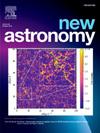对 SPH 进行修改,以实现具有内部海洋的冰质卫星的三维模拟
IF 1.9
4区 物理与天体物理
Q2 ASTRONOMY & ASTROPHYSICS
引用次数: 0
摘要
一些冰卫星存在内部海洋的痕迹,如木卫二和土卫二的蒸汽羽流。这意味着在表面冰壳下有一个液态水区域。由于液态水是生命起源的必要条件,因此了解这些内部海洋的发展,特别是其温度分布和演化非常重要。潮汐加热和辐射冷却之间的平衡被认为是维持冰月表面下液态水的关键。我们的目标是利用平滑粒子流体力学(SPH)方法进行三维数值流体计算,模拟冰月内部海洋的潮汐加热。我们在 SPH 的控制方程中加入了粘度和热传导项。然而,在使用带有粘性项的 SPH 计算刚体旋转时,我们遇到了两个问题:(1) 传统的粘性公式会产生阻碍旋转的非物理力;(2) 由于标准的 SPH 公式,分层结构中存在人为的内部能量分配。为了解决第一个问题,我们修改了粘度公式。针对第二个问题,我们采用了之前研究中开发的密度独立 SPH(DISPH),以改善不连续表面的行为。此外,我们还通过粒子法定义流体表面的算法实现了辐射冷却。我们还引入了考虑相变的状态方程。通过这些修改,我们完善了 SPH 方法,使其包含了模拟具有内部海洋的冰卫星演变的所有必要物理过程。本文章由计算机程序翻译,如有差异,请以英文原文为准。
Modifications of SPH towards three-dimensional simulations of an icy moon with internal ocean
There are some traces of the existence of internal ocean in some icy moons, such as the vapor plumes of Europa and Enceladus. This implies a region of liquid water beneath the surface ice shell. Since liquid water would be essential for the origin of life, it is important to understand the development of these internal oceans, particularly their temperature distribution and evolution. The balance between tidal heating and radiative cooling is believed to sustain liquid water beneath an icy moon’s surface. We aim to simulate the tidal heating of an internal ocean in an icy moon using 3-dimensional numerical fluid calculations with the Smoothed Particle Hydrodynamics (SPH) method. We incorporated viscosity and thermal conduction terms into the governing equations of SPH. However, we encountered two issues while calculating rigid body rotation using SPH with a viscous term: (1) conventional viscosity formulations generated unphysical forces that hindered rotation, and (2) there was artificial internal energy partitioning within the layered structure, which was due to the standard SPH formulations. To address the first issue, we modified the viscosity formulation. For the second, we adopted Density Independent SPH (DISPH) developed in previous studies to improve behavior at discontinuous surfaces. Additionally, we implemented radiative cooling using an algorithm to define fluid surfaces via the particle method. We also introduced an equation of state accounting for phase transitions. With these modifications, we have refined the SPH method to encompass all necessary physical processes for simulating the evolution of icy moons with internal oceans.
求助全文
通过发布文献求助,成功后即可免费获取论文全文。
去求助
来源期刊

New Astronomy
地学天文-天文与天体物理
CiteScore
4.00
自引率
10.00%
发文量
109
审稿时长
13.6 weeks
期刊介绍:
New Astronomy publishes articles in all fields of astronomy and astrophysics, with a particular focus on computational astronomy: mathematical and astronomy techniques and methodology, simulations, modelling and numerical results and computational techniques in instrumentation.
New Astronomy includes full length research articles and review articles. The journal covers solar, stellar, galactic and extragalactic astronomy and astrophysics. It reports on original research in all wavelength bands, ranging from radio to gamma-ray.
 求助内容:
求助内容: 应助结果提醒方式:
应助结果提醒方式:


